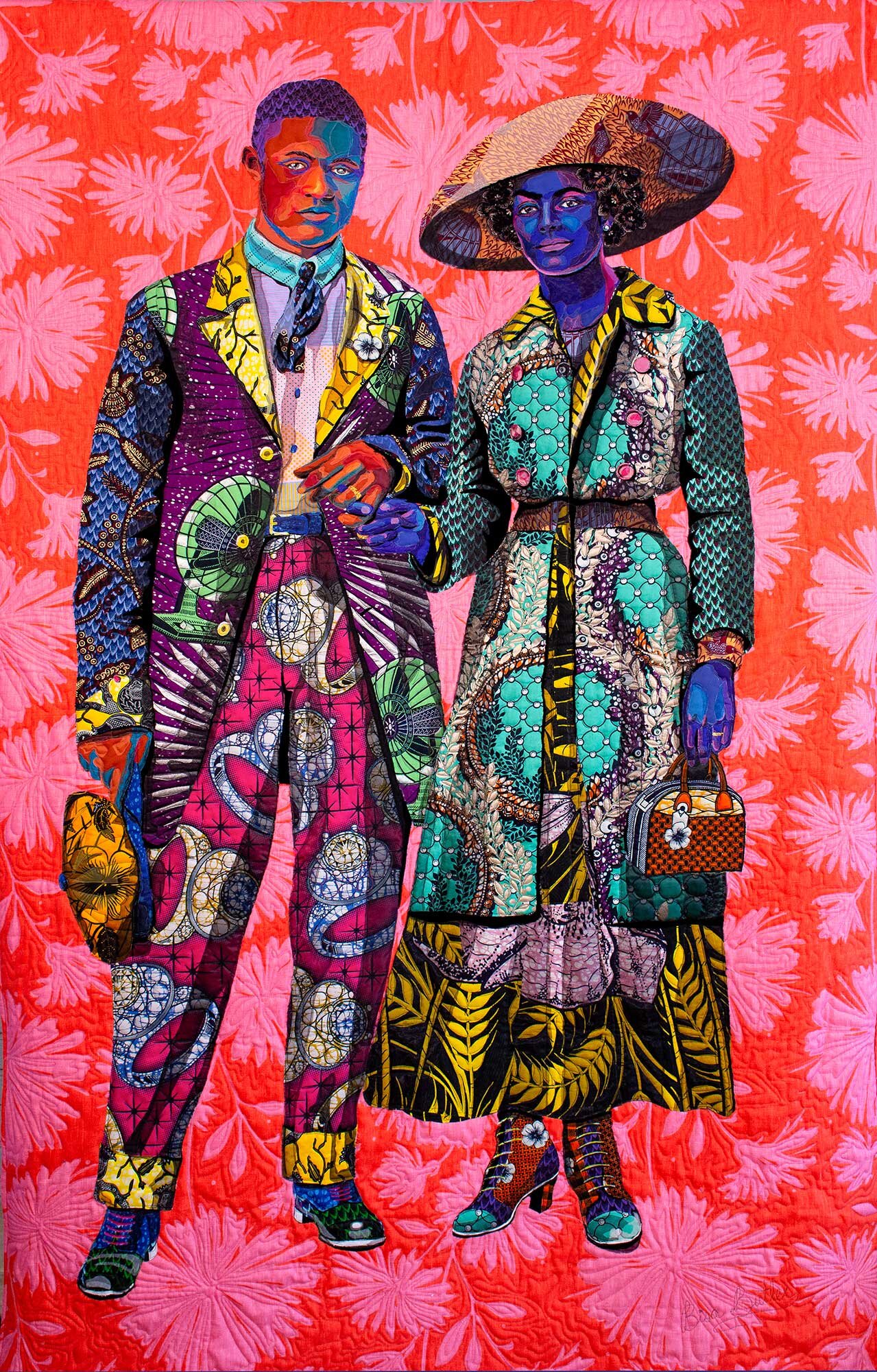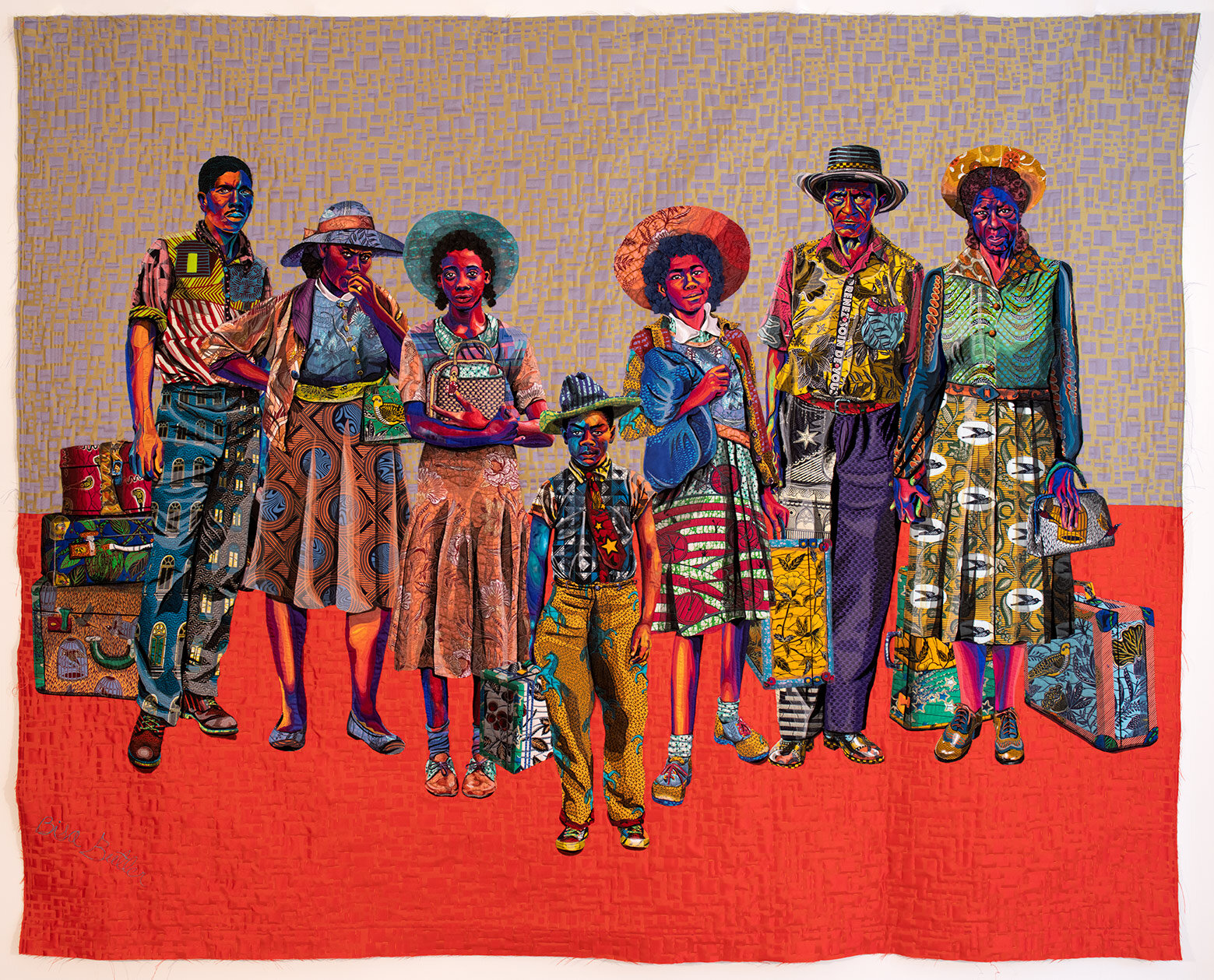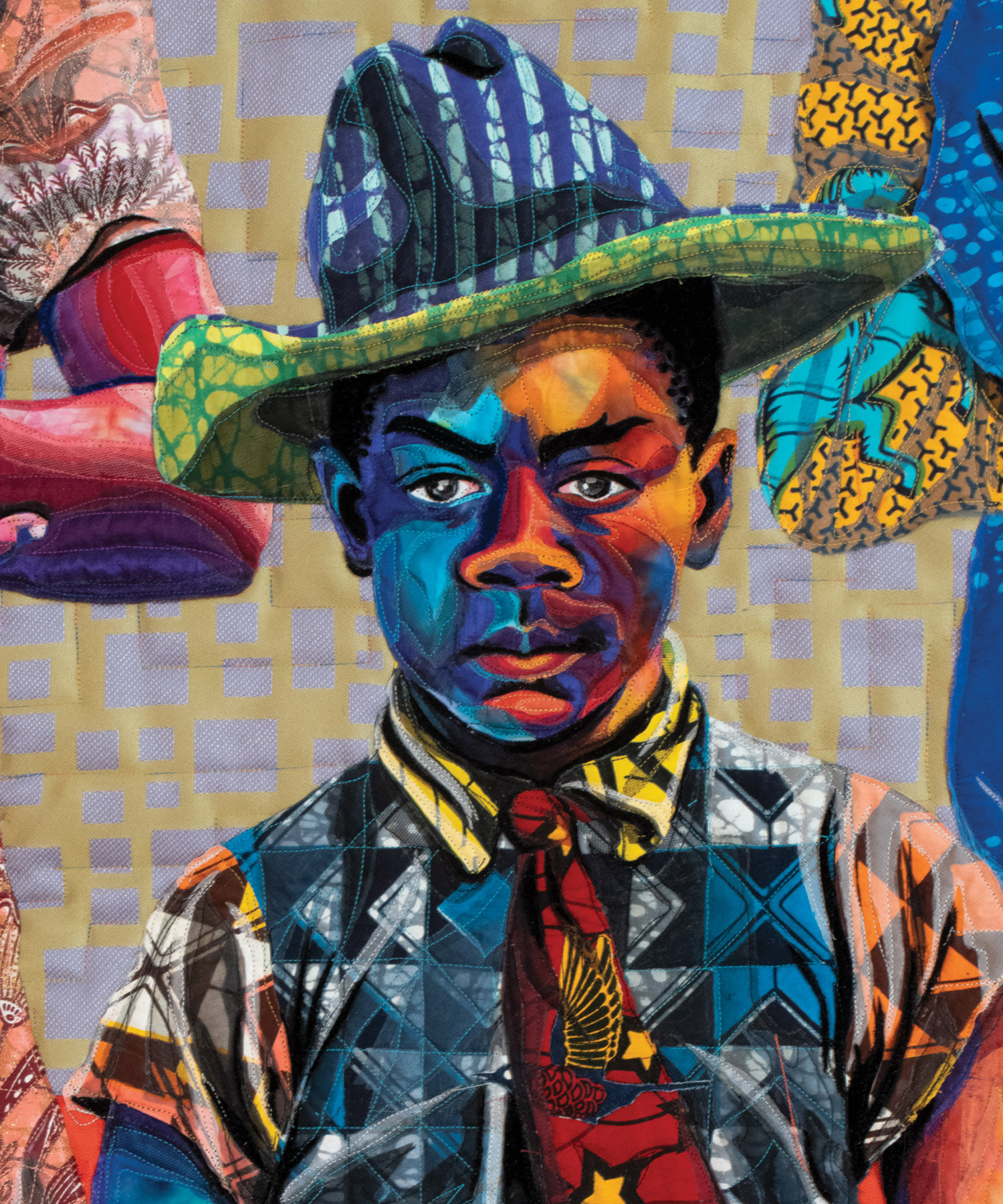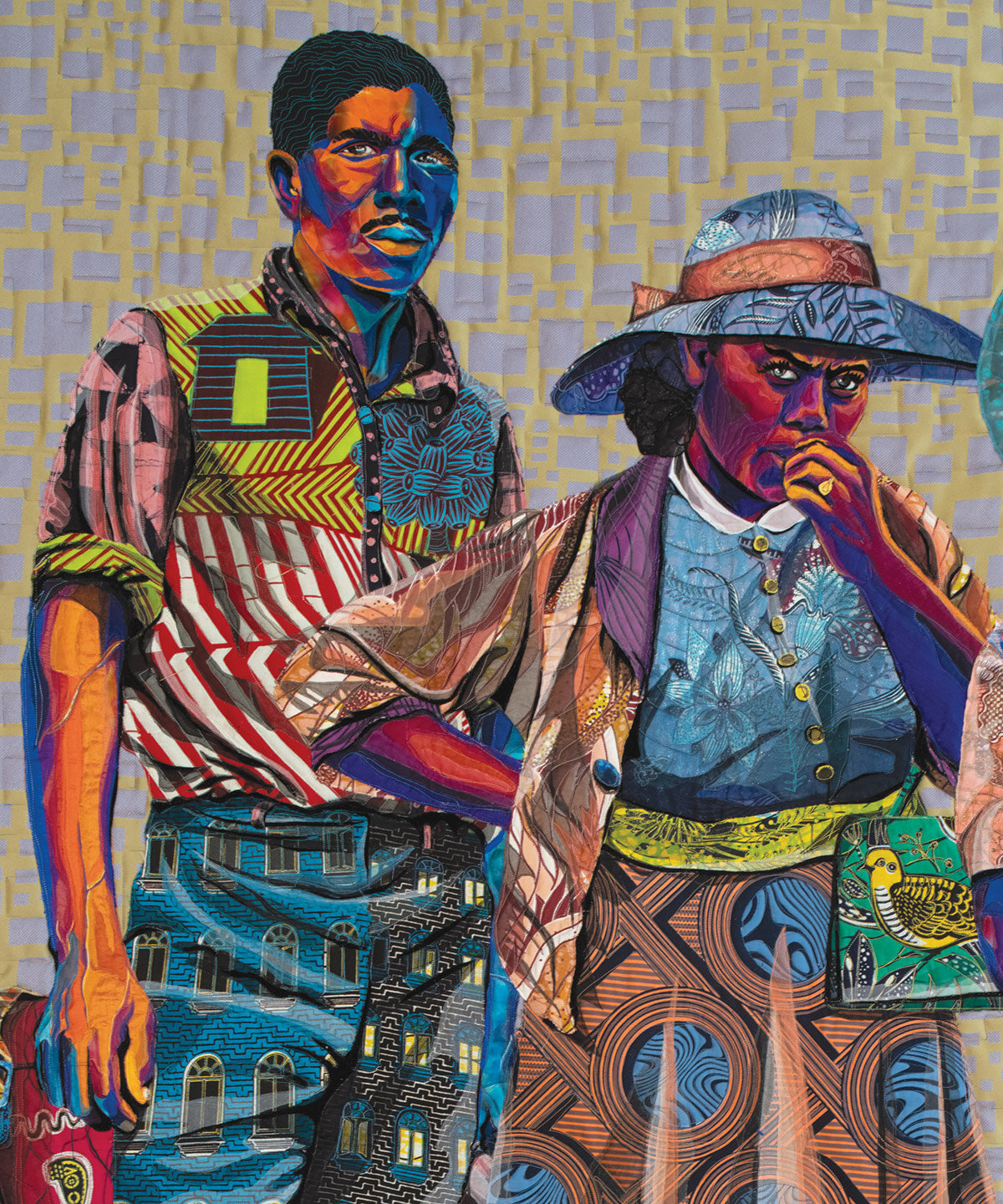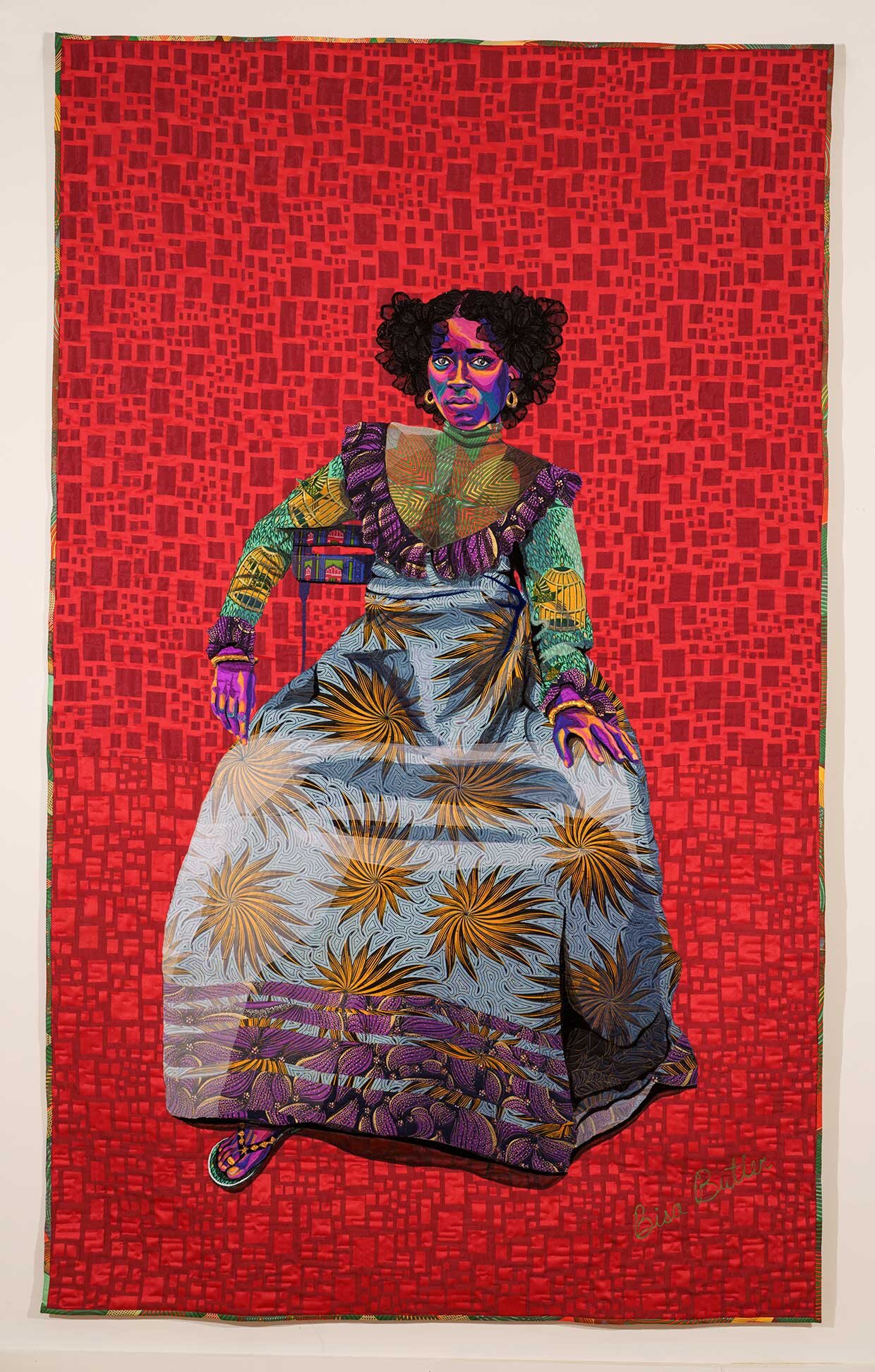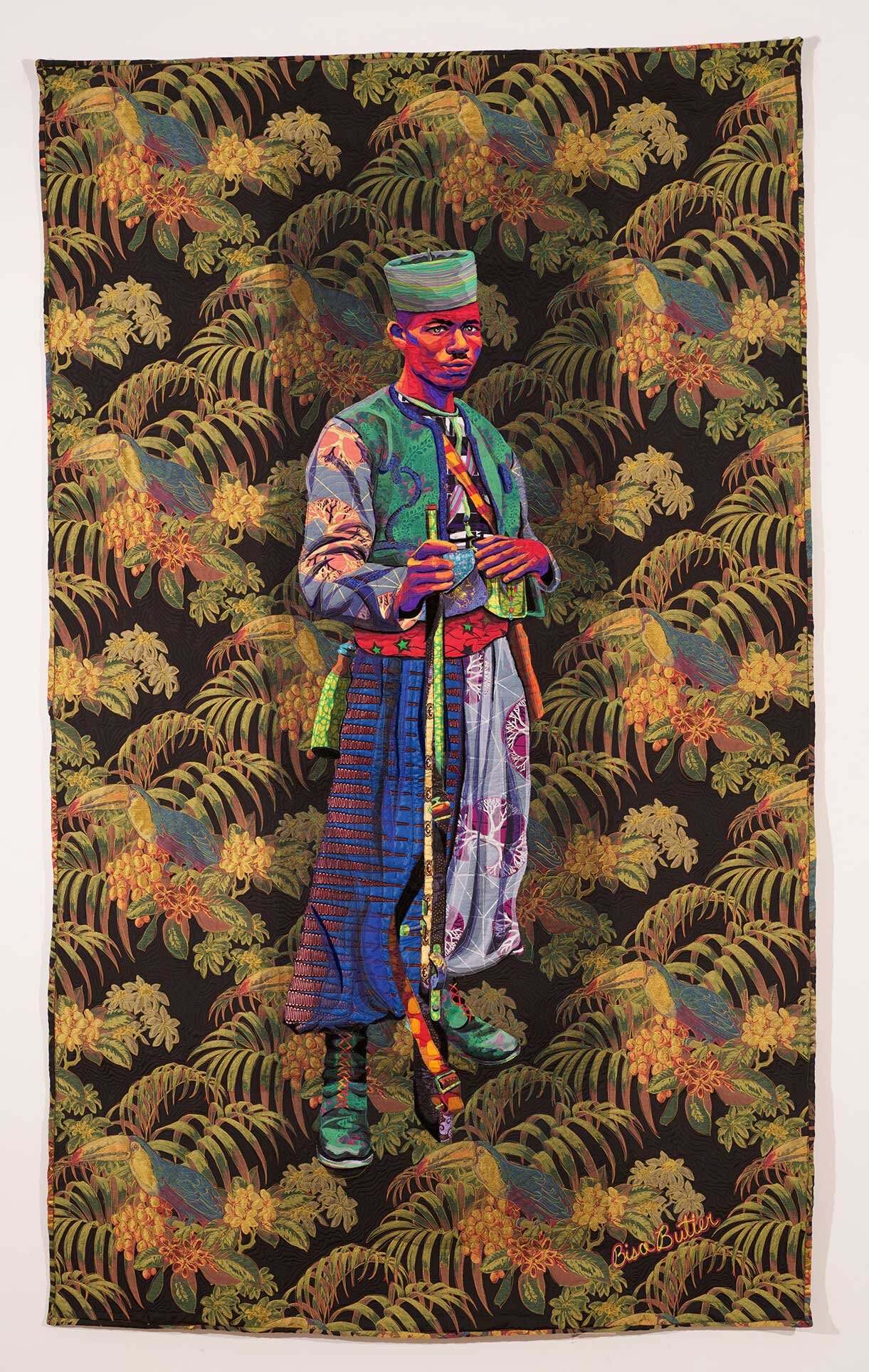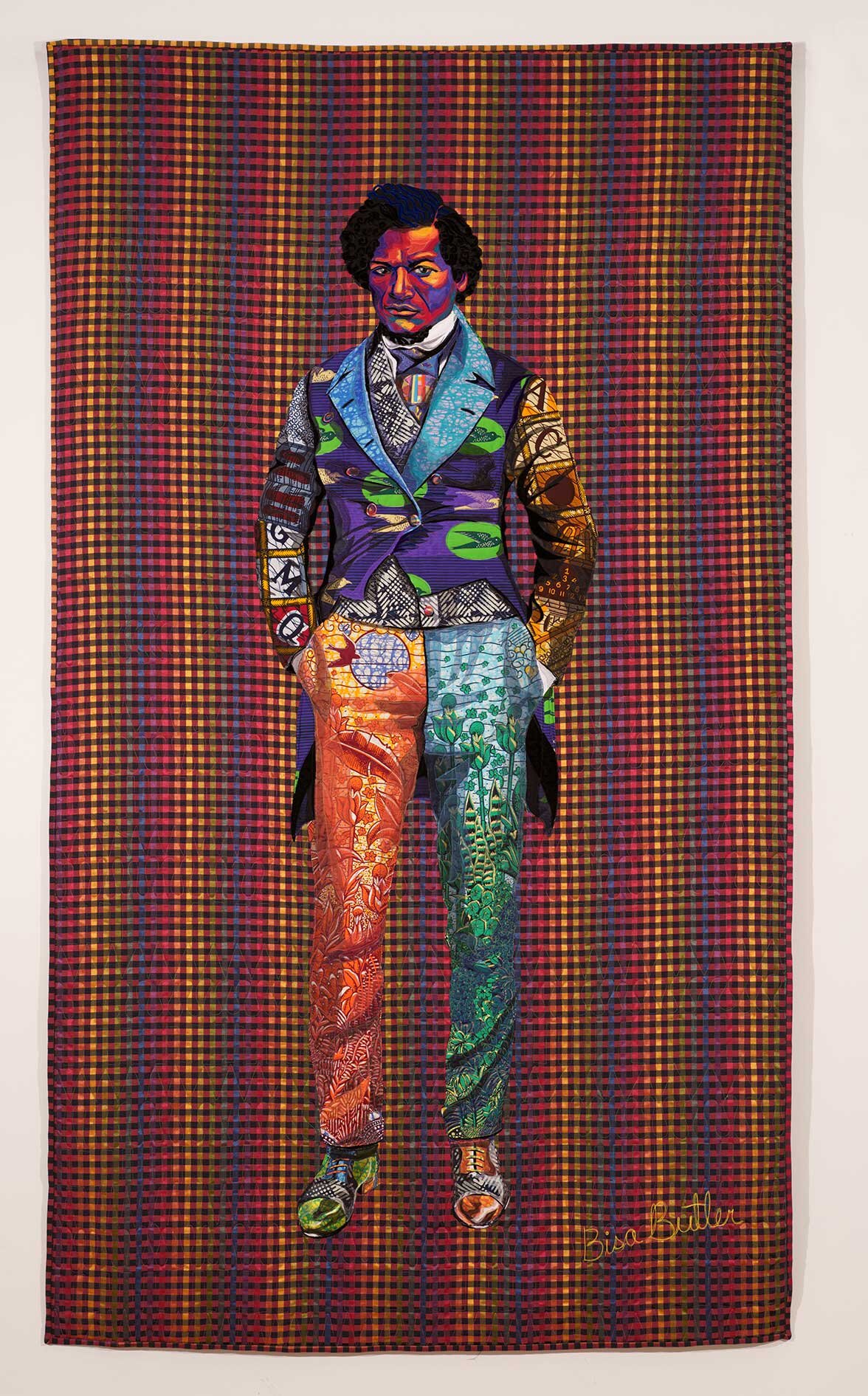Bisa Butler; Giving back Identity, History & Legacy
AUTHOR: ARTSY CHOW ROAMER
Artist Bisa Butler
GIVING BACK IDENTITY, HISTORY & LEGACY
I recently became aware of the stunning textile portraits of New Jersey artist Bisa Butler while flipping through a magazine. I turned the page and these fabulous colors, patterns and faces just leapt out at me. Nearly full-sized people stitched into quilts that stared back as if I were taking their photograph.
It caused me to stop and really study the quilt of four small African American girls in their Sunday best with white socks and black shoes smiling shyly back at the photographer; those faces telling a story captured in an archival black and white photograph that Butler used to produce the quilt.
That is what Bisa is doing with these portraits. She is a storyteller at heart and wants to “give back identity, history and legacy” to the faces in the many photographs she has looked through. Many of those pictures were untitled and others had simple titles like Negro Boys on Easter Morning. Who were those boys? What were they doing? How did they feel about being photographed and who took the pictures?
Butler is a graduate of Howard University; a historical all black college or HBCU. One of the founding elements of attending an HBCU is that “if you are lucky enough to get to go to college, it is your responsibility to take back what you learn to your community” so those that can’t attend can benefit from your education and experiences.
Many of the arts faculty have come directly out of the 60’s Chicago way of thinking of “AfriCOBRA”. That meaning that being black is beautiful; you should have pride in your culture and be you. You are not a darker skinned white person. You don’t have to assimilate; you can still be your own person.
Continuing, “do your art but you also have a duty to keep talking to your people and address their suffering”. Butler connected with that and struggled to find her way through painting at first. But everything seemed flat to her. She learned to sew before she ever knew how to paint, so a professor suggested she try to incorporate fabric into her paintings to give them a collage effect.
Bisa picked a portrait to paint and applied her fabrics. Upon completion she carried it to class to stunned silence and wows by her fellow art students. An idea was born and perhaps a mission as well.
SEWING WITH GRANDMOTHER & MOTHER
As a girl, Bisa watched her grandmother and mother sew clothing. They would look at the designers of the day like Dior and Halston and copy the looks. She started learning to sew with the leftover scraps of cloth they gave her from those designs.
These were fancier fabrics for ladies’ dresses; not what quilters would normally use. Her grandmother gathered fabrics from Africa and cool fabrics with that 70’s feeling of brightly colored flowers and textures. A legacy was begun with the act of sewing, quilting and passing down fabrics in the way it had begun for African Americans under slavery in the old South.
Large pieces of fabric were never given to slaves. They got scraps and old clothes and fashioned both clothing and quilts for warmth from those different pieces. They got so good at it that more than a few slave owners had some of those beautiful quilts on their own beds for long cold winters.
QUILTING
Bisa got pregnant just as she was graduating from Howard. Painting became an impossibility since the smell of paint made her feel nauseated. Out of that time came her decision to go to graduate school and quilting fit her lifestyle more than painting did with a small toddler.
She started doing portraits of friends and family with all her colorful scraps she had gathered over the years. One of her first portraits with a story was her own paternal grandfather. She never met him. He died in Africa in the 1940’s but she thought about the sad story of how his dying had impacted the family in such a big way.
They were torn apart because of the death and a lack of money or options. There weren’t any pictures of the grandfather so Bisa decided to do a portrait based on what she thought he might have looked like. The African fabrics from her grandmother proved to be perfect for this use. The portrait was a hit and it just “felt right” to the artist.
RISING STAR
Bisa’s debut solo show this past February was at Claire Oliver Gallery located in Harlem in New York City. The show, entitled The Storm, the Whirlwind and the Earthquake, was a reference to a famous speech made by Frederick Douglas rebuking the nation for celebrating freedom when slavery was still going on. The show drew a huge crowd. There was already buzz around this rising star in a way you don’t often see anywhere outside of New York galleries.
For her subjects, Bisa chose pictures from an archive collection never really seen by the general public. The photographs were commissioned by the US government for photographers to go out and document the “status of the Negro peoples” during and after World War II.
The photographs were available online and most had no titles as to who they were; usually just a notation of where the photos had been taken. Most of the photos will never be seen and that touched the storyteller heart of the artist. She felt they deserved better. Their identity, history and legacies should be given back to them and shared with the greater community as well.
African Americans have been marginalized over the years since slavery with no documentation of the names, their contributions and credit given for the building of this nation and the white wealth it spawned. Most people don’t even realize that the White House was built by slaves.
TELLING THEIR STORIES HER WAY
As she looked through the photographs, she was taken with a little boy standing next to a porch in Georgia. He had on overalls, a cap and was barefoot. Bisa felt he stared out with the judging eyes of an adult just as we would be judging the photograph of him.
She made the decision to give him what he would want to have instead of what life had actually provided. She gave him some cool shoes, a motorcycle man on his pocket, horses and airplanes on his bibs. By using African fabrics, she felt she was giving back the legacy that was stolen from him.
She treated him like he was her own little boy. After all, she spends 100-200 hours sewing on each story quilt. She is emotionally invested by the time she completes one and the people depicted do seem like her own family and community to her.
In all of the pictures she saw “a sense of dignity and beauty in their lives”. It was already there and just something she needed to expose. All the photos throughout this post are from the series she developed for her show.
Each tell a story and reveal the lives of the African Americans living in the US at the time in a different and unique way. The Warmth of Sons appears to be a shot of several generations of family and each face provides a very readable take on the individuals feelings about the photography session and perhaps the US government in general.
Butler’s quilt perfectly captures every emotion on each of the faces from curiosity and friendliness, to anger and outright suspicion and distrust. It is all there and just as easily readable as the original photograph must have been.
Les Sapeurs is a nod to the members of the Societe des Ambianceurs et des Personnes Elegantes (the Society of Tastemakers and Elegant People). Begun by the Congolese men after the colonization of the Congo by the French, they attempt to imitate the style, fashion and look of the wealthy.
LETTER TO A MOTHER
One of the pieces I studied the longest that had the most emotional pull for me was Dear Mama. Bisa laid an interesting photo of a mother and daughter over a letter written in a child’s cursive handwriting. The letter speaks to the love and appreciation the child feels for her mother.
The mother looks a little impatient and less than pleased while the girl looks like she is both sad and a little mad. What is happening?
As bits of the letter are revealed and some are hidden, we just can’t be sure of exactly what is going on. The beauty of any story is that sometimes different meanings can come out of if depending on who is viewing it; as it has always been with art too. The pressing question remains “What do you see”?
Most of the pieces are in sizes of 50-60 inches wide and 70-85 inches tall. This makes it very easy to feel like you are interacting with real people eye to eye and are a part of the story as it is revealed to you.
AFRICAN FABRICS OFFER COLORFUL BEAUTY
Butler is choosing the patterns and textures of her African fabrics with a purpose that supports her underlying storytelling. It is hard not to feel the fun in Broom Jumpers as an homage to the joy of a young couple starting their lives together by getting married and observing that West African wedding custom.
The sense of military implied in the pieces entitled Asantewa and Zouave is also apparent. The former meaning warrior and the latter a nod to both the French Algerian uniform and the volunteer units of the American Civil War.
Daughter of the Dust is a movie based on the psychic and spiritual conflicts among the women of the Peazant family, a Gullah clan that makes the painful decision to migrate to the American mainland. The signature piece for the show called The Storm is immediately recognizable as a young Frederick Douglas.
Butler explains more about her process
CONCLUSION
I find this work so compelling. I feel joy in the compositions and fabrics that are so beautiful and stunning in their textural complexity with cotton, wool, silk, velvet and chiffon all on view. The size of the pieces make them so much bigger and more important than small photographs ever could have done for their subjects.
The thought of the photographs themselves is what breaks my heart, a sad reminder of the original sin of slavery and its consequences, the photographs taken by a government that has never lived up to the written words and promises made on paper.
These photographs were never really seen and will never be viewed by the public. They were never shown to the individuals who posed for them. Their stories were undocumented, their identities secret, their history and legacies unrecorded…until now.
Look for Butler’s upcoming work which will tackle the stories of those who have passed from police violence before, during and after the days of the Black Lives Matter protests. She will sadly have plenty of photographs to choose from for the series and will no doubt tackle these stories in the same serious, thoughtful and emotional way she did for the unknowns. Make sure you see that work.
If you enjoyed what you read, you might also like other posts under Artful Ideal. Hey, don’t be a stranger! Let me know what you think about Bisa’s work and if it moves you as much as it did me. Look for my next post with some of my favorite Christmas cookies and recipes for the holidays. Until then…
Cheers!
ArtsyChowRoamer
Follow me on You Tube, Facebook, Pinterest, Instagram & Twitter
Art
If you like what you read, click on the button below!
Why? You’ll get free tips on how to start your own amazing art collection (even on a budget) plus other great stuff I promise you’ll want!





